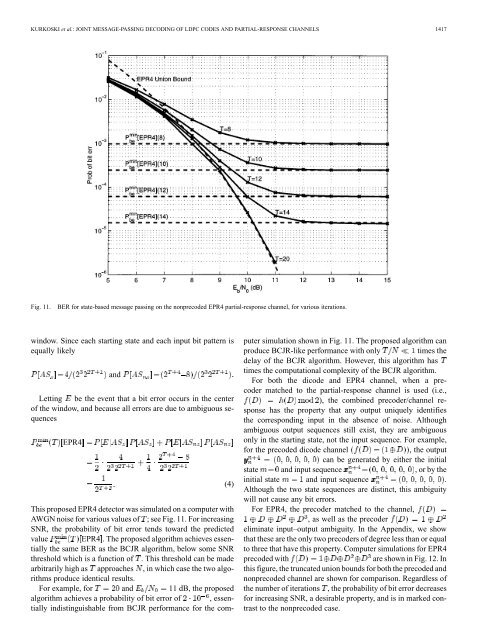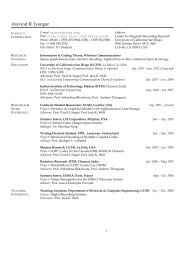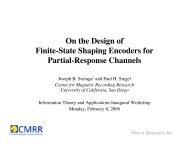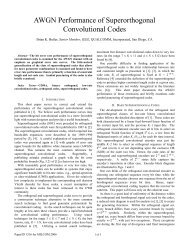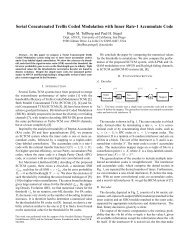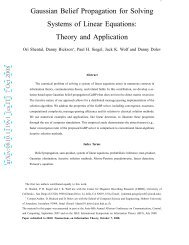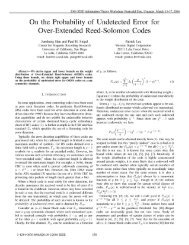Joint message-passing decoding of LDPC codes and ... - CiteSeerX
Joint message-passing decoding of LDPC codes and ... - CiteSeerX
Joint message-passing decoding of LDPC codes and ... - CiteSeerX
You also want an ePaper? Increase the reach of your titles
YUMPU automatically turns print PDFs into web optimized ePapers that Google loves.
KURKOSKI et al.: JOINT MESSAGE-PASSING DECODING OF <strong>LDPC</strong> CODES AND PARTIAL-RESPONSE CHANNELS 1417<br />
Fig. 11.<br />
BER for state-based <strong>message</strong> <strong>passing</strong> on the nonprecoded EPR4 partial-response channel, for various iterations.<br />
window. Since each starting state <strong>and</strong> each input bit pattern is<br />
equally likely<br />
<strong>and</strong><br />
Letting be the event that a bit error occurs in the center<br />
<strong>of</strong> the window, <strong>and</strong> because all errors are due to ambiguous sequences<br />
EPR4<br />
(4)<br />
This proposed EPR4 detector was simulated on a computer with<br />
AWGN noise for various values <strong>of</strong> ; see Fig. 11. For increasing<br />
SNR, the probability <strong>of</strong> bit error tends toward the predicted<br />
value EPR4 . The proposed algorithm achieves essentially<br />
the same BER as the BCJR algorithm, below some SNR<br />
threshold which is a function <strong>of</strong> . This threshold can be made<br />
arbitrarily high as approaches , in which case the two algorithms<br />
produce identical results.<br />
For example, for <strong>and</strong> 11 dB, the proposed<br />
algorithm achieves a probability <strong>of</strong> bit error <strong>of</strong> , essentially<br />
indistinguishable from BCJR performance for the computer<br />
simulation shown in Fig. 11. The proposed algorithm can<br />
produce BCJR-like performance with only times the<br />
delay <strong>of</strong> the BCJR algorithm. However, this algorithm has<br />
times the computational complexity <strong>of</strong> the BCJR algorithm.<br />
For both the dicode <strong>and</strong> EPR4 channel, when a precoder<br />
matched to the partial-response channel is used (i.e.,<br />
), the combined precoder/channel response<br />
has the property that any output uniquely identifies<br />
the corresponding input in the absence <strong>of</strong> noise. Although<br />
ambiguous output sequences still exist, they are ambiguous<br />
only in the starting state, not the input sequence. For example,<br />
for the precoded dicode channel<br />
, the output<br />
can be generated by either the initial<br />
state <strong>and</strong> input sequence , or by the<br />
initial state <strong>and</strong> input sequence .<br />
Although the two state sequences are distinct, this ambiguity<br />
will not cause any bit errors.<br />
For EPR4, the precoder matched to the channel,<br />
, as well as the precoder<br />
eliminate input–output ambiguity. In the Appendix, we show<br />
that these are the only two precoders <strong>of</strong> degree less than or equal<br />
to three that have this property. Computer simulations for EPR4<br />
precoded with<br />
are shown in Fig. 12. In<br />
this figure, the truncated union bounds for both the precoded <strong>and</strong><br />
nonprecoded channel are shown for comparison. Regardless <strong>of</strong><br />
the number <strong>of</strong> iterations , the probability <strong>of</strong> bit error decreases<br />
for increasing SNR, a desirable property, <strong>and</strong> is in marked contrast<br />
to the nonprecoded case.


